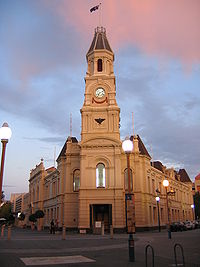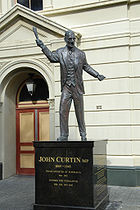
Fremantle Town Hall
Encyclopedia

Fremantle, Western Australia
Fremantle is a city in Western Australia, located at the mouth of the Swan River. Fremantle Harbour serves as the port of Perth, the state capital. Fremantle was the first area settled by the Swan River colonists in 1829...
and situated on the corner of High, William and Adelaide Streets. The opening coincided with the celebration of Victoria's
Victoria of the United Kingdom
Victoria was the monarch of the United Kingdom of Great Britain and Ireland from 20 June 1837 until her death. From 1 May 1876, she used the additional title of Empress of India....
Jubilee and occurred on 22 June 1887.
Plans
On 7 June 1876, Councillor E. H. Higham suggested that the Council should approach the Colonial Secretary to have a Government Reserve, on the corner of South Terrace and Essex Street, set aside to build a Town Hall. The use of the site was approved by the Governor of the time, Sir William RobinsonSir William Robinson
Sir William Robinson was a British colonial governor who was the last Governor of Trinidad and the first Governor of the merged colony of Trinidad and Tobago. He was also the 11th Governor of Hong Kong....
, who offered convict labour for the construction as well as free design and specification preparation by the Government Engineer and promised to seek a liberal grant from the Legislative Council for the construction project.
The Government Engineer drafted plans that did not survive to this day.
On 11 July a ratepayers meeting talked of the funds needed to build the Town Hall and W. E. Marmion unsuccessfully suggested that a more central site in High Street be purchased instead. Plans did not go ahead as funding could not be met.
The more central site that had been previously suggested was bought by the Council after the Church of England
Church of England
The Church of England is the officially established Christian church in England and the Mother Church of the worldwide Anglican Communion. The church considers itself within the tradition of Western Christianity and dates its formal establishment principally to the mission to England by St...
decided to demolish the church located on High Street to rebuild elsewhere.
In April 1881, the Chairman of the Council again raised the matter of the Town Hall. He proposed a building to cost no more than £8000. Attempts to raise funds locally failed, and the architect behind the plans was rejected for the plans of Melbourne based architects Grainger and D'Ebro
Charles D'Ebro
Charles Abraham D'Ebro was a London-born architect who designed many important buildings in Melbourne, Victoria, Australia during the late Victorian and early Edwardian periods...
.
Building Stage
Tenders were called in 1884 but none were chosen as they all exceeded the budget. After further modifications to the design, tenders were recalled and only one builder, Edward V. Keane, put forward a tender with four separate price ranges. These ranged from £19,832 to £12,400. The Council decided to accept this builder but decided only to go ahead with the auditorium, supper room, kitchen and vestibule.
The foundation stone was laid on 10 September 1885 by Governor
Governor of Western Australia
The Governor of Western Australia is the representative in Western Australia of Australia's Monarch, Queen Elizabeth II. The Governor performs important constitutional, ceremonial and community functions, including:* presiding over the Executive Council;...
Frederick Napier Broome
Frederick Broome
Sir Frederick Napier Broome KCMG was a colonial administrator in the British Empire.He was born in Canada, but was living in England in 1865, when he married Mary Anne Barker...
. The opening was set for 22 June to coincide with the celebration of the Queen's Jubilee, after a seven month delay. Building commenced on 28 May 1885 and the original finishing date was to be 28 November 1886.
The opening ceremony was followed by a day of sports and a ball in the evening.
The death of W.J. Snook
The following evening, a children’s fancy dress ball was held in the Hall. The Town Supervisor, W. J. Snook, and two other men had some trouble in keeping a group of rowdy men out of the Hall. Amongst the group was the landlord of the National Hotel in High Street, W. Conroy who gatecrashed the supper just after midnight, as the Mayor was congratulating the stewards and officials on the 'happy conclusion of the Jubilee'. It was past 1 a.m. when Conroy was seen in the courtyard and soon after a shot was heard. Allegedly, Conroy had shot Snook because Snook would not let him in. Despite his injuries, Snook lived for 3 more months before passing away in September. Conroy was tried for the crime and has the distinction of being the last man to be hanged at Perth GaolPerth Gaol
The Perth Gaol was a gaol built in Perth, Western Australia between 1854 and 1856 to house convicts and other prisoners. It operated until March 1888 when the last prisoner was transferred to Fremantle Prison...
.

